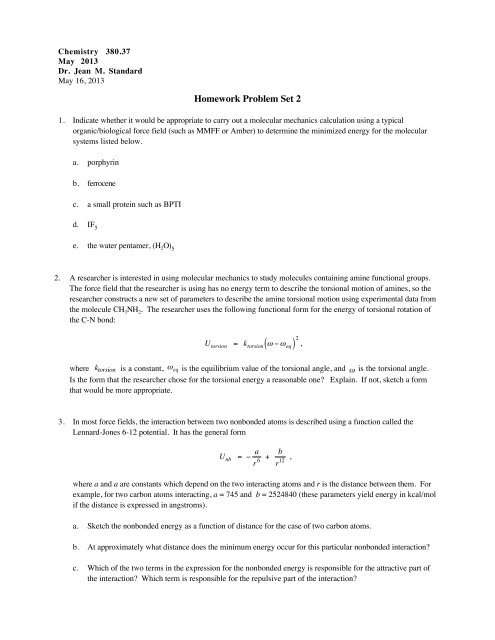Homework Problem Set 2
Homework Problem Set 2
Homework Problem Set 2
You also want an ePaper? Increase the reach of your titles
YUMPU automatically turns print PDFs into web optimized ePapers that Google loves.
Chemistry 380.37<br />
May 2013<br />
Dr. Jean M. Standard<br />
May 16, 2013<br />
<strong>Homework</strong> <strong>Problem</strong> <strong>Set</strong> 2<br />
1. Indicate whether it would be appropriate to carry out a molecular mechanics calculation using a typical<br />
organic/biological force field (such as MMFF or Amber) to determine the minimized energy for the molecular<br />
systems listed below.<br />
a. porphyrin<br />
b. ferrocene<br />
c. a small protein such as BPTI<br />
d. IF 5<br />
e. the water pentamer, (H 2 O) 5<br />
2. A researcher is interested in using molecular mechanics to study molecules containing amine functional groups.<br />
The force field that the researcher is using has no energy term to describe the torsional motion of amines, so the<br />
researcher constructs a new set of parameters to describe the amine torsional motion using experimental data from<br />
the molecule CH 3 NH 2 . The researcher uses the following functional form for the energy of torsional rotation of<br />
the C-N bond:<br />
U torsion = k torsion ( ω − ω eq ) 2 ,<br />
where k torsion is a constant, ω eq is the equilibrium value of the torsional angle, and ω is the torsional angle.<br />
Is the form that the researcher chose € for the torsional energy a reasonable one Explain. If not, sketch a form<br />
that would be more appropriate.<br />
€<br />
3. In most force fields, the interaction between two nonbonded atoms is described using a function called the<br />
Lennard-Jones 6-12 potential. It has the general form<br />
U nb = − a<br />
r 6 + b<br />
r 12 ,<br />
where a and a are constants which depend on the two interacting atoms and r is the distance between them. For<br />
example, for two carbon atoms interacting, € a = 745 and b = 2524840 (these parameters yield energy in kcal/mol<br />
if the distance is expressed in angstroms).<br />
a. Sketch the nonbonded energy as a function of distance for the case of two carbon atoms.<br />
b. At approximately what distance does the minimum energy occur for this particular nonbonded interaction<br />
c. Which of the two terms in the expression for the nonbonded energy is responsible for the attractive part of<br />
the interaction Which term is responsible for the repulsive part of the interaction<br />
€
2<br />
4. A computational chemist working at DrugsRUs, Inc. performed an energy minimization using the Amber force<br />
field on the lactic acid molecule and found that the lowest energy conformer had an energy of 19.856 kcal/mol.<br />
Upon carrying out a literature search, the chemist found a journal article from 1995 in which a study using the<br />
MMFF force field determined the global minimum for lactic acid to be 3.898 kcal/mol. Is there something<br />
wrong with the DrugsRUs chemist’s work Explain.<br />
5. The part of a particular MM3-like force field that describes stretching energy for an O-H single bond is given by<br />
the following expression:<br />
U s = 380( r − r eq ) 2 − 75( r − r eq ) 3 ,<br />
where r is the O-H bond distance , r eq= 1.044 Å, and the stretching energy U s is expressed in kcal/mol. Notice<br />
that in many force fields based € on MM3, the harmonic stretching energy is corrected by an anharmonic term like<br />
the cubic one shown above. A molecule is built on the computer with an initial O-H bond distance of 1.320 Å.<br />
€<br />
€<br />
a. What is the stretching energy of the O-H bond with r = 1.320 Å<br />
b. What is the gradient of the energy with respect to the O-H bond at r = 1.320 Å<br />
c. What is the curvature at r = 1.320 Å<br />
d. Using the Newton-Raphson method for geometry optimization, carry out one step to determine the new<br />
value of r.<br />
e. Calculate the gradient at the new value of r determined in part (d). If the tolerance for reaching the<br />
minimum is that the absolute value of the gradient be less than or equal to 0.1 kcal/mol-Å, is the<br />
optimization complete<br />
6. Consider the energies of the axial and equatorial forms of t-butylcyclohexane.<br />
a. Which form would you expect to be higher in energy, the axial or equatorial Why<br />
b. Do molecular mechanics calculations agree with your qualitative expectations Use the data below to verify<br />
the relative energies of the two forms.<br />
Energy of t-butylcyclohexane calculated using MM3 and Amber force fields (kcal/mol)<br />
Force Field Bonds Angles Torsions Nonbonded Total<br />
Axial<br />
MM3 1.517 4.281 5.458 6.625 18.313<br />
Amber 0.732 4.434 1.837 4.303 11.305<br />
Equatorial<br />
MM3 1.394 1.969 3.755 5.892 13.312<br />
Amber 0.584 1.465 0.311 3.989 6.350<br />
c. From the force field data given in part (b), what element of the force field shows the largest change when<br />
comparing the axial and equatorial conformations Why do you suppose this is

















